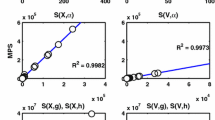Abstract
We provide a geometric framework for investigating the robustness of information flows over biological networks. We use information measures to quantify the impact of knockout perturbations on simple networks. Robustness has two components, a measure of the causal contribution of a node or nodes, and a measure of the change or exclusion dependence, of the network following node removal. Causality is measured as statistical contribution of a node to network function, wheras exclusion dependence measures a distance between unperturbed network and reconfigured network function. We explore the role that redundancy plays in increasing robustness, and how redundacy can be exploited through error-correcting codes implemented by networks. We provide examples of the robustness measure when applied to familiar boolean functions such as the AND, OR and XOR functions. We discuss the relationship between robustness measures and related measures of complexity and how robustness always implies a minimal level of complexity.
Similar content being viewed by others
References
Albert, R., Jeong, H., Barabasi, A.L., 2000. Error and attack tolerance of complex networks. Nature 406, 378–382.
Amari, S., 1985. Differential-Geometric Methods in Statistics, Lecture Notes in Statistics, vol. 28. Springer, Heidelberg.
Amari, S., Nagaoka, H., 2000. Methods of Information Geometry, AMS Translations of Mathematical Monographs, vol. 191. Oxford University Press, Oxford.
Barkai, N., Leibler, S., 1997. Robustness in simple biochemical networks. Nature 376, 307–312.
Bialek, W., Nemenman, I., Tishby, N., 2001. Predictability, Complexity, and Learning. Neural Comput. 13, 2409–2463.
Callaway, D.S., Newman, J.E.J., Strogatz, S.H., Watts, D.J., 2000. Network robustness and fragility: percolation on random graphs. Phys. Rev. Lett. 85, 5468–5471.
Chosmky, N., 1981. Principles and parameters in syntactic theory. In: Hornstein, N., Lightfoot, D. (Eds.), Explations in Linguistics. Longman, London.
Cover, T.M., Thomas J.A., 2001. Elements of Information Theory. Wiley, New York.
Crutchfield, J.P., Packard, N.H., 1983. Symbolic, dynamics of noisy chaos. Physica D 7, 201–223.
de Visser, J.A.G.M., Hermisson, J., Wagner, G.P., Meyers, L.A., Bagheri-Chaichian, H., Blanchard, J.L., Chao, L., Cheverud, J.M., Elena, S.F., Fontana, W. Gibson, G., Hansen, T.F., Krakauer, D., Lewontin, R.C., Ofria, C., Rice, S.H., von Dassow, G., Wagner, A., Whitlock, M.C., 2003. Evolution and detection of genetic robustness. Evolution 57, 1959–1972.
Dunne, J.A., Williams, R.J., Martinez, N.D., 2002. Networks structure and biodiversity loss in food webs: robustness increases with connectance. Ecol. Lett. 5, 558.
Erb, I., Ay, N., 2003. Multi-information in the thermodynamic limit. J. Stat. Phys. 115, 949–976.
Flack, J., Girvan, M., de Waal, F., Krakauer, D.C., 2006. Policing stabilizes construction of social niches in primates. Nature, 439, 426–429.
Friedberg, E.C., 1985. DNA Repair. W.H. Freeman, New York.
Grassberger, P., 1986. Toward a quantitative theory of self-generated complexity. Int. J. Theor. Phys. 25 (9), 907–938.
Krakauer, D.C., 2003. Genetic Redundancy, Evolution and Comparative Genomics. Encyclopedia of the human genome. Nature Publishing Group. MacMillan Publishers, New York.
Krakauer, D.C., 2004. Robustness in biological systems: a provisional taxonomy. In: T.S. Dreisboeck, J. Yasha Kresh. (Eds.), Complex Systems Science in Biomedicine, Kluwer Academic Press, Dordrecht.
Krakauer, D.C., Nowak, M.A., 1999. Evolutionary preservation of redundant duplicated genes. Semin. Cell. Dev. Biol. 10, 555–559.
Krakauer, D.C., Plotkin, J.B., 2002. Redundancy, antiredundancy, and the robustness of genomes. Proc. Natl. Acad. Sci. USA 99, 1405–1409.
Krakauer, D.C., Plotkin, J.B., 2004. Principles and parameters of molecular robustness. In: Jen, E. (Ed.), Robust Design: A Repertoire for Biology, Ecology and Engineering. Oxford University Press, Oxford, pp. 115–133.
Newman, M., 2003. The structure and function of complex networks. SIAM Rev. 45, 167–256.
Pearl, J., 2000. In: Causality. Cambridge University Press, Cambridge.
Peterson, W.W., Weldon, E.J., 1972. Error Correcting Codes. MIT Press, Cambridge, MA.
Schuster, P., Fontana, W., Stadler, P.F., Hofacker, I.L., 1994. From sequences to shapes and back: a case study in RNA secondary structures. Proc. Roy. Soc. (London) B, 255, 279–284 (1994).
Shmulevich, I., Lahdesmaki, H., Dougherty, E.R., Zhang, W., 2003. The role of certain postclasses in Boolean network models of genetic networks. Proc. Natl. Acad. Sci. USA 100, 10734–10739.
Strogatz, S.H., 2001. Exploring complex networks. Nature 410, 268–276.
Tononi, G., Sporns, O., Edelman, G.M., 1994. A measure for brain complexity: relating functional segregation and integration in the nervous system. Proc. Natl. Acad. Sci. USA 91, 5033–5037.
Tyson, J.J., Chen, K., Novak, B., 2001. Network dynamics and cell physiology. Nat. Rev. Mol. Bio. 2, 908–916.
van Baalen, M., Krivan, V., van Rijn, P.C.J., Sabelis, M.W., 2001. Alternative food, switching predators, and the persistence of predator-prey systems. Am. Nat. 157.
Wagner, A., 1994. Evolution of gene networks by gene duplications: a mathematical model and its implications on genome organization. Proc. Natl. Acad. Sci. USA 91, 4387–4391.
Wagner, A., 2000. Robustness against mutations in genetic networks of yeast. Nat. Genet. 24, 355–361.
Wagner, A., 2005. Robustness and Evolvability in Living Systems. Princeton University Press, Princeton, NJ.
Author information
Authors and Affiliations
Corresponding author
Rights and permissions
About this article
Cite this article
Ay, N., Krakauer, D.C. Geometric robustness theory and biological networks. Theory Biosci. 125, 93–121 (2007). https://doi.org/10.1016/j.thbio.2006.06.002
Received:
Accepted:
Issue Date:
DOI: https://doi.org/10.1016/j.thbio.2006.06.002




